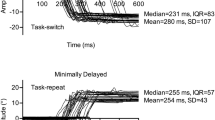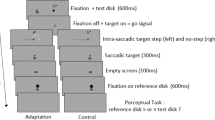Abstract
Antisaccades entail decoupling the spatial relations between stimulus and response and executing a saccade to a target’s mirror-symmetrical location. The indirect spatial relations require that a relative target percept supports antisaccade sensorimotor transformations. Here, we sought to identify whether the percept supporting antisaccades results in a respective over- and undershooting bias for the near and far targets within a stimulus-set (i.e., oculomotor range effect hypothesis) or renders an eccentricity-specific bias based on a statistical summary of the individual target percepts in a stimulus-set (i.e., perceptual averaging hypothesis). Antisaccades (and complementary prosaccades) were completed in separate blocks (i.e., proximal and distal) that contained an equal number of target eccentricities, but differed with respect to their magnitudes. The proximal block included eccentricities of 3.0°, 5.5°, 8.0°, 10.5°, and 13.0°, whereas the distal block included eccentricities of 10.5°, 13.0°, 15.5°, 18.0°, and 20.5°. The proximal block showed that antisaccade amplitudes to the central target (8.0°) did not elicit a reliable bias, whereas the block’s ‘near’ (3.0° and 5.5°) and ‘far’ (10.5° and 13.0°) targets produced an over- and undershooting bias, respectively. Notably, however, the distal block showed a reliable—and large magnitude—undershooting bias for the central target (i.e., 15.5°): a bias that generalized to each target within the block. Taken together, results for the proximal and distal blocks are incompatible with the range effect hypothesis. Instead, results indicate that the visual percept supporting antisaccades is based on the statistical summary of the range of target eccentricities within a stimulus-set (i.e., perceptual averaging). Moreover, perceptual averaging represents a parsimonious basis by which the oculomotor system can specify sensorimotor transformations via non-veridical (i.e., relative) visual information.



Similar content being viewed by others
Notes
We recognize that Kapoula’s (1985) work reported that prosaccades elicit a range effect. Importantly, however, Gillen et al’s (2013) re-examination of Kapoula’s data provides no evidence of a reliable range effect. As well, Gillen et al’s empirical findings provide direct evidence that prosaccades reliably undershot veridical target location independent of the magnitude and range of target eccentricities from within the block in which they were performed. In other words, Gillen et al’s findings support extensive evidence that prosaccades are governed by an invariant oculomotor strategy that minimizes saccade flight time (Harris 1995) and/or the energy requirements of the task (Becker 1989).
Visual space (left, right) was included as an initial variable in our initial ANOVA model; however, it did not elicit a significant effect or interaction Fs < 1.72 (see also Gillen et al. 2013; Heath et al. 2011; Weiler and Heath 2014). As such, visual space was included as a collapsed factor in our main analyses.
We used Loftus and Masson’s (1994) method for computing confidence intervals in a within-participant design.
Within-participant confidence intervals were computed separately for proximal and distal blocks via the mean squared error term for task (Loftus and Masson 1994). For that reason, the confidence intervals for proximal block pro- and antisaccades are the same as the confidence intervals for distal block pro- and antisaccades.
References
Abrams RA, Meyer DE, Kornblum S (1989) Speed and accuracy of saccadic eye movements: characteristics of impulse variability in the oculomotor system. J Exp Psychol Hum Percep Perf 15:529–543
Albrecht AR, Scholl BJ, Chun MM (2012) Perceptual averaging by eye and ear: computing summary statistics from multimodal stimuli. Atten Percept Psychophys 74:810–815
Ariely D (2001) Seeing sets: representation by statistical properties. Psychol Sci 12:157–162
Baird JC, Noma EJ (1978) Fundamentals of scaling and psychophysics. Wiley, New York
Becker W (1989) The neurobiology of saccadic eye movements. Metrics. Rev Oculomot Res 3:13–67
Becker W, Fuchs AF (1969) Further properties of the human saccadic system: eye movements and correction saccades with and without visual fixation points. Vis Res 9:1247–1258
Bell AH, Everling S, Munoz DP (2000) Influence of stimulus eccentricity and direction on characteristics of pro- and antisaccades in non-human primates. J Neurophysiol 84:2595–2604
Brainard DH (1997) The psychophysics toolbox. Spat Vis 10:433–436
Chong SC, Treisman A (2003) Representation of statistical properties. Vis Res 43:393–404
Cisek P (2007) Cortical mechanisms of action selection: the affordance competition hypothesis. Philos Trans R Soc Lond B Biol Sci 362:1585–1599
Corbett JE, Oriet C (2011) The whole is indeed more than the sum of its parts: perceptual averaging in the absence of individual item representation. Acta Psychol (Amst) 138:289–301
Cumming G (2013) Understanding the new statistics: effect sizes, confidence intervals, and meta-analysis. Routledge, New York
Dafoe JM, Armstrong IT, Munoz DP (2007) The influence of stimulus direction and eccentricity on pro- and anti-saccades in humans. Exp Brain Res 179:563–570
Davarpanah Jazi S, Heath M (2014) Weber’s law in tactile grasping and manual estimation: feedback-dependent evidence for functionally distinct processing streams. Brain Cogn 86:32–41
Deubel H, Wolf W, Hauske G (1986) Adaptive gain control of saccadic eye movements. Hum Neurobiol 5:245–253
Dorris MC, Olivier E, Munoz DP (2007) Competitive integration of visual and preparatory signals in the superior colliculus during saccadic programming. J Neurosci 27:5053–5062
Evdokimidis I, Tsekou H, Smyrnis N (2006) The mirror antisaccade task: direction-amplitude interaction and spatial accuracy characteristics. Exp Brain Res 174:304–311
Fischer B, Weber H (1992) Characteristics of “anti” saccades in man. Exp Brain Res 89:415–424
Gaveau V, Martin O, Prablanc C, Pélisson D, Urquizar C, Desmurget M (2003) On-line modification of saccadic eye movements by retinal signals. NeuroReport 14:875–878
Gerardin P, Gaveau V, Pélisson D, Prablanc C (2011) Integration of visual information for saccade production. Hum Mov Sci 30:1009–1021
Gillen C, Heath M (2014) Asymmetrical weighting of target eccentricities within a trial block influence antisaccade endpoint bias. Poster presented at the meeting of the Vision Sciences Society, St. Pete’s Beach, FL
Gillen C, Weiler J, Heath M (2013) Stimulus-driven saccades are characterized by an invariant undershooting bias: no evidence for a range effect. Exp Brain Res 230:165–174
Hallett PE (1978) Primary and secondary saccades to goals defined by instructions. Vis Res 18:1279–1296
Harris CM (1995) Does saccadic undershoot minimize saccadic flight-time? A Monte-Carlo study. Vis Res 35:691–701
Harris CM, Wolpert DM (1998) Signal-dependent noise determines motor planning. Nature 394:780–784
He PY, Kowler E (1989) The role of location probability in the programming of saccades: implications for “center-of-gravity” tendencies. Vis Res 29:1165–1181
Heath M (2005) Role of limb and target vision in the online control of memory-guided reaches. Mot Control 9:281–311
Heath M, Dunham K, Binsted G, Godbolt B (2010) Antisaccades exhibit diminished online control relative to prosaccades. Exp Brain Res 203:743–752
Heath M, Weiler J, Marriott K, Welsh TN (2011) Vector inversion diminishes the online control of antisaccades. Exp Brain Res 209:117–127
Kalesnykas RP, Hallett PE (1994) Retinal eccentricity and the latency of eye saccades. Vis Res 34:517–531
Kapoula Z (1985) Evidence for a range effect in the saccadic system. Vis Res 25:1155–1157
Kimmig H, Greenlee MW, Gondan M, Schira M, Kassubek J, Mergner T (2001) Relationship between saccadic eye movements and cortical activity as measured by fMRI: quantitative and qualitative aspects. Exp Brain Res 141:184–194
Knapp JM, Loomis JM (2004) Limited field of view of head-mounted displays is not the cause of distance underestimation in virtual environments. Presence Teleoper Virtual Environ 13:572–577
Kowler E, Blaser E (1995) The accuracy and precision of saccades to small and large targets. Vis Res 35:1741–1754
Krappmann P, Everling S, Flohr H (1998) Accuracy of visually and memory-guided antisaccades in man. Vis Res 38:2979–2985
Lemay M, Proteau L (2001) A distance effect in a manual aiming task to remembered targets: a test of three hypotheses. Exp Brain Res 140:357–368
Loftus GR, Masson ME (1994) Using confidence intervals in within-subject designs. Psychon Bull Rev 1:476–490
Moon SY, Barton JJ, Mikulski S, Polli FE, Cain MS, Vangel M, Hämäläinen MS, Manoach DS (2007) Where left becomes right: a magnetoencephalographic study of sensorimotor transformation for antisaccades. Neuroimage 36:1313–1323
Munoz DP, Everling S (2004) Look away: the anti-saccade task and the voluntary control of eye movement. Nat Rev Neurosci 5:218–228
Nyffeler T, Hartmann M, Hess CW, Müri RM (2008) Visual vector inversion during memory antisaccades—a TMS study. Prog Brain Res 171:429–432
Pedhazur EJ (1997) Multiple regression in behavioral research: explanation and prediction. Harcourt Brace College Publishers, Orlando
Poulton EC (1981) Human manual control. Comprehensive physiology. Wiley, New York
Prablanc C, Jeannerod M (1975) Corrective saccades: dependence on retinal reafferent signals. Vis Res 15:465–469
Robinson DA (1964) The mechanics of human saccadic eye movement. J Physiol 174:245–264
Robinson DA (1971) Models of oculomotor neural organization. In: Bach-y-Rita P, Collins C, Hyde JE (eds) The control of eye movements. Academic Press, New York, pp 515–538
Sheth BR, Shimojo S (2001) Compression of space in visual memory. Vis Res 41:329–341
Viguier A, Clément G, Trotter Y (2001) Distance perception within near visual space. Perception 30:115–124
Von Helmholtz H (1867) Handbuch der physiologischen optikoptical Society of America, reprinted 1962. Dover, New York
Walker R, Deubel H, Schneider WX, Findlay JM (1997) Effect of remote distractors on saccade programming: evidence for an extended fixation zone. J Neurophysiol 78:1108–1119
Weber RB, Daroff RB (1971) The metrics of horizontal saccadic eye movements in normal humans. Vis Res 11:921–928
Weiler J, Heath M (2012) The prior-antisaccade effect influences the planning and online control of prosaccades. Exp Brain Res 216:545–552
Weiler J, Heath M (2014) Repetitive antisaccade execution does not increase the unidirectional prosaccade switch-cost. Acta Psychol (Amst) 146:67–72
Westwood DA, Heath M, Roy EA (2003) No evidence for accurate visuomotor memory: systematic and variable error in memory-guided reaching. J Mot Behav 35:127–133
Wurtz RH, Albano JE (1980) Visual-motor function of the primate superior colliculus. Annu Rev Neurosci 3:189–226
Zhang M, Barash S (2000) Neuronal switching of sensorimotor transformations for antisaccades. Nature 408:971–975
Acknowledgments
Supported by a Grant from the Natural Sciences and Engineering Research Council of Canada and Major Academic Development Fund and Faculty Scholar Awards from the University of Western Ontario.
Author information
Authors and Affiliations
Corresponding author
Rights and permissions
About this article
Cite this article
Gillen, C., Heath, M. Perceptual averaging governs antisaccade endpoint bias. Exp Brain Res 232, 3201–3210 (2014). https://doi.org/10.1007/s00221-014-4010-1
Received:
Accepted:
Published:
Issue Date:
DOI: https://doi.org/10.1007/s00221-014-4010-1




